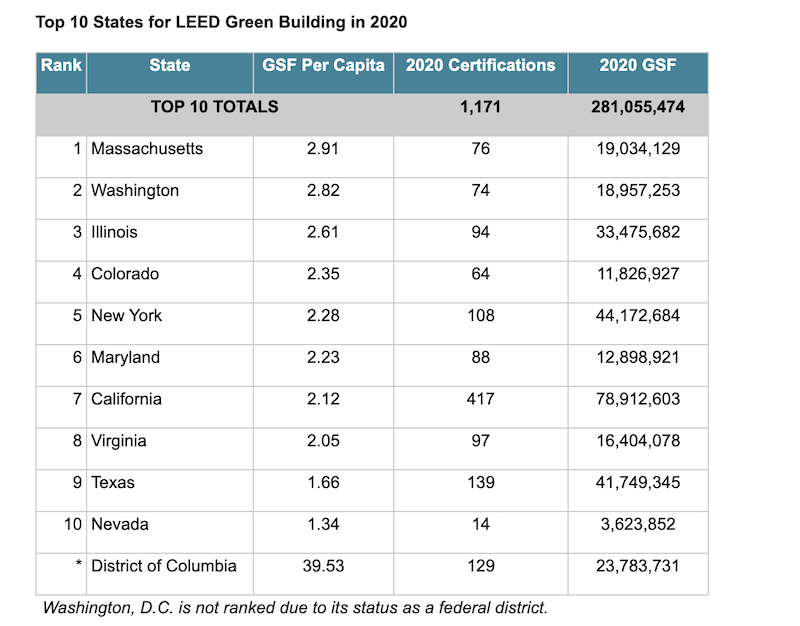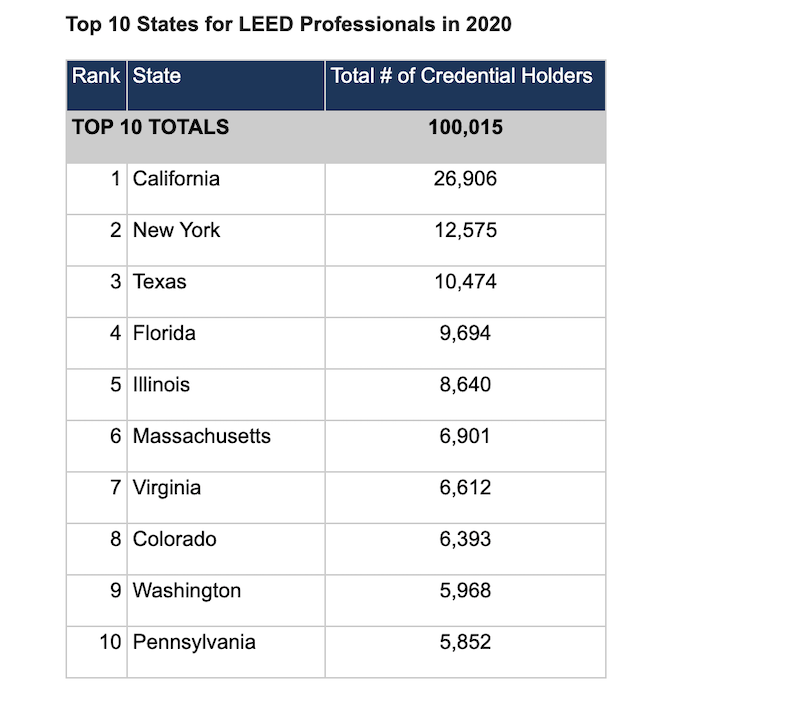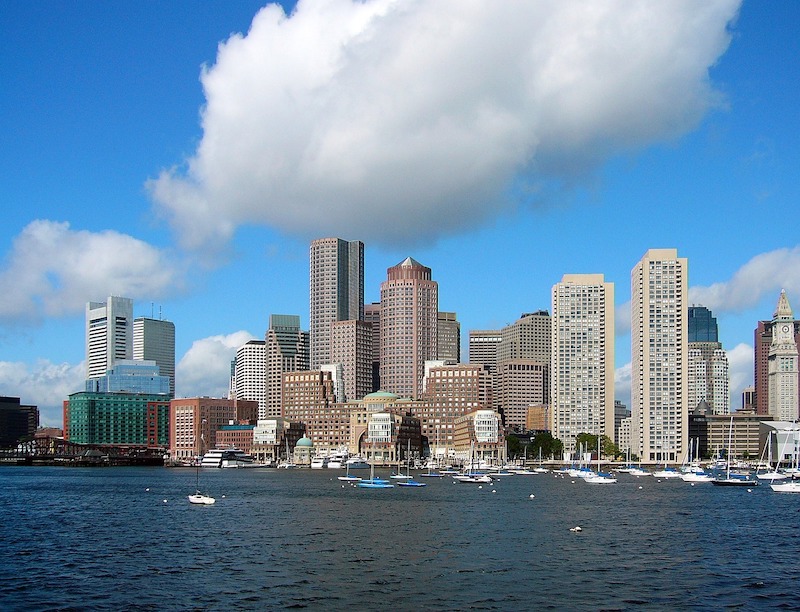The U.S. Green Building Council (USGBC) released its annual list of the Top 10 States for LEED green building with Massachusetts leading the country in 2020 with the most certified square feet per capita. Across the top states, more than 60% of certifications were office, healthcare, higher education and K-12 projects. This year, USGBC also released a ranking of states with the most LEED professionals with California taking the top spot. Collectively, the 2020 rankings represent 1,171 certified LEED buildings and spaces, and more than 100,000 green building workers.
“If we are to rebuild an economy that supports our health and our planet, we must lead with changing the way we design and build,” said Mahesh Ramanujam, president and CEO of USGBC. “Last year was a stark reminder that the quality of our buildings impacts the quality of our life. Looking ahead, people want to trust that the spaces they occupy are good for them and their communities, and LEED has always been a tool to support those goals. Now is the time to ensure that every building is LEED certified as that is the only way we are accomplishing our goals of access to healthy, green buildings, homes and spaces.”
While offices, education and healthcare projects accounted for a majority of certifications, warehouses, distribution centers, multifamily and retail projects represented almost 20%. Also, almost half of all projects were certified Gold, indicating a commitment to a high level of certification.
The Top 10 States for LEED green building is based on gross square feet of certified space per person using 2010 U.S. Census data and includes commercial and institutional projects certified in 2020. The full top 10 state rankings are as follows:

The global green building community is continually improving LEED to ensure it helps buildings, communities and cities to be more sustainable, healthy, resilient and equitable. More than two-thirds of LEED credits support human health, as the rating system addresses ventilation and filtration, daylighting, low-emitting materials, access to outdoor spaces, acoustics and other key factors. In response to the COVID-19 pandemic, USGBC also introduced Safety First guidance to address operational challenges and assist with each state’s re-entry planning.
LEED’s foundation, however, is in its commitment to help the building sector reduce its contribution to climate change. Certification communicates progress in support of climate and ESG commitments and the goal is to get more buildings on a path to certify. Using Arc to track performance, USGBC is tracking nearly 56 million metrics tons of GHG emissions associated with energy and transportation, and more than 167 billion gallons of water. The data show that LEED projects deliver significant reductions in emissions and improvements in occupant experience - and the benefits increase with higher levels of LEED certification. The latest version of the rating system, LEED v4.1, raises the bar on green building performance, defining the latest sustainability standards while enabling project teams to continue to track progress beyond certification.
“If we want to make a positive impact in our communities, we must transform the building sector, and focus on what the data is telling us,” added Ramanujam. “By putting data at the center of LEED we’re helping teams better understand building performance, find ways to improve and ultimately find a path to net zero.”
Since 2018, more than 25 projects globally have certified LEED Zero, which recognizes net zero performance in buildings and spaces. LEED’s third-party certification is the industry’s dominant green building standard and LEED Zero expands on that work verifying achievements in net zero carbon, energy, water and waste. It focuses on a higher level of green building performance.
Transforming the building sector to be more sustainable requires a skilled and knowledgeable workforce. This workforce is contributing to the development and advocacy of LEED and is being quickly embraced by the next generation workforce and decision makers. USGBC has been committed to cultivating and supporting green building professionals through its credentialing and certificate programs. This year, USGBC is also releasing an additional Top 10 list recognizing states with the most LEED green building professionals. The full list is as follows:

More information about LEED certification and green building is available at usgbc.org.
Related Stories
Market Data | Oct 31, 2016
Nonresidential fixed investment expands again during solid third quarter
The acceleration in real GDP growth was driven by a combination of factors, including an upturn in exports, a smaller decrease in state and local government spending and an upturn in federal government spending, says ABC Chief Economist Anirban Basu.
Market Data | Oct 28, 2016
U.S. construction solid and stable in Q3 of 2016; Presidential election seen as influence on industry for 2017
Rider Levett Bucknall’s Third Quarter 2016 USA Construction Cost Report puts the complete spectrum of construction sectors and markets in perspective as it assesses the current state of the industry.
Industry Research | Oct 25, 2016
New HOK/CoreNet Global report explores impact of coworking on corporate real rstate
“Although coworking space makes up less than one percent of the world’s office space, it represents an important workforce trend and highlights the strong desire of today’s employees to have workplace choices, community and flexibility,” says Kay Sargent, Director of WorkPlace at HOK.
Market Data | Oct 24, 2016
New construction starts in 2017 to increase 5% to $713 billion
Dodge Outlook Report predicts moderate growth for most project types – single family housing, commercial and institutional building, and public works, while multifamily housing levels off and electric utilities/gas plants decline.
High-rise Construction | Oct 21, 2016
The world’s 100 tallest buildings: Which architects have designed the most?
Two firms stand well above the others when it comes to the number of tall buildings they have designed.
Market Data | Oct 19, 2016
Architecture Billings Index slips consecutive months for first time since 2012
“This recent backslide should act as a warning signal,” said AIA Chief Economist, Kermit Baker.
Market Data | Oct 11, 2016
Building design revenue topped $28 billion in 2015
Growing profitability at architecture firms has led to reinvestment and expansion
Market Data | Oct 4, 2016
Nonresidential spending slips in August
Public sector spending is declining faster than the private sector.
Industry Research | Oct 3, 2016
Structure Tone survey shows cost is still a major barrier to building green
Climate change, resilience and wellness are also growing concerns.
Industry Research | Sep 27, 2016
Sterling Risk Sentiment Index indicates risk exposure perception remains stable in construction industry
Nearly half (45%) of those polled say election year uncertainty has a negative effect on risk perception in the construction market.

















